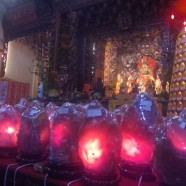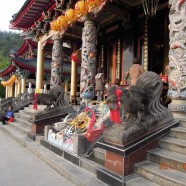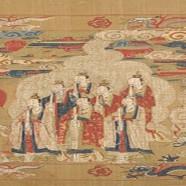Immortal Peaches of Xiwangmu (part 2)
Tiger Shaman: Goddess from the West Who is this Goddess hail from the West? What are her origins, and her special gifts to humanity? Her origins can be traced back to oracle bone inscriptions of the 15th century BCE that record sacrifices to a “western mother”. Originally called Xiwangmu (西王母), literally “Western Queen Mother,” she was a primordial divinity with her headquarters to the west of China. However, so powerful was her stature that she was deserving of ritual by the people of the Shang dynasty, Therefore, Xiwangmu isn’t even an indigenous deity. Her roots are Shamanic, and she was something fierce, and she came before organized Taoism. She appears first in writings dating to the Western Han dynasty (206 BC – AD 9). The earliest known mention of her in the “Guideways of Mountains and Seas“(山海經). The profile that emerges is that of a powerful woman shaman who lived up in the snowy mountains, gathering around her a following compelled by her awesome powers and personal charisma. The very first depictions of her showed her with tiger teeth and a leopard tail! During the Zhou Dynasty, Xiwangmu was depicted as a ferocious goddess with the teeth of a tiger, who sent disease and pestilence down upon the world. A thousand years passed. When the Silk Routes were opened up by 2nd century BCE, and traffic and trade picked up in northern and western parts of China, Xiwangmu was adopted into the Taoist pantheon. Eventually she was raised to the level of Top Goddess, Primordial Yin. Her name became synonymous as dispenser of abundance, long life, and eternal bliss. Xiwangmu was given a Han name, the Han being the largest ethnic race in China proper. That name is Gold Mother of Shining Lake. As the name suggests, her vibration is that of pure golden luminosity. Her domain/field evokes the sparkling, fluidity of plasmic string theory. In my articles I will use the names Xiwangmu and Gold Mother interchangeably, since they represent the same entity with minor variations. Kunlun Mountain, Semi-Mythical Paradise The Queen Mother of the West presides over a palace paradise on the semi-mythical Mount Kunlun, in the etheric realm. Incidentally, there is a modern Mount Kunlun named after this. It is the longest mountain range in Asia. From the Pamirs of Tajikistan, it runs east along the border between Xinjiang and Tibet autonomous regions to the Sino-Tibetan ranges in Qinghai province. That is why she is called Queen Mother of the West. She is not an indigenous deity from China mainland, but an exotic “spiritual configuration” imported from the West. The mythical Mount Kunlun was believed to be a cosmic pillar, a meeting place between humans and the gods. And Xiwangmu’s domain (a parallel reality to ours) is sheer bliss and utter perfection. In modern times Xiwangmu has further evolved into an endearing Goddess She is often lovingly called Wang Niángniang (王母娘娘), Nanny, and Queen Mother. Peaches of Immortality! According to Chinese Taoist texts, next to Xiwangmu’s palace is a most luxuriant orchard where she groomed ‘peaches of immortality. ‘ In the fantastic novel, Monkey (Journey to the West, 16th century), Monkey is guilty of crashing Xiwangmu’s birthday party, and gulping down all the peaches of immortality so there were none left for her guests. You can bet the Queen Mother wasn’t quite happy with Monkey! To this day, pan tou (flat peaches from Shandong Province, the most priced and delicious!) are still associated with longevity, and in Chinese birthday parties, steamed sweet buns served up in the shape of lush peaches, stuffed with lotus seed...
Read MoreGold Mother of Shining Lake (瑤池金母) (part 1)
Encounter at the Mineral Spa “Gold Mother has yet another title. Wu Ji Li Tian (無極理天). She is the Divine Logos beyond all form. Roughly, her name can mean “The Realm of Infinite Possibility beyond all polarity.” A mild winter’s day in Beitou. I slide easily into the flowing waters of the Beitou mineral spa, and its silky warmth entices me into a dreamy, trance-like state. My head is still spinning from the encounter just now at the private temple of Yaochi Jinmu (瑤池金母), or the Golden Mother of the Shining Lake. Her other name is Xiwangmu, Queen Mother from the West. If you have read the famous Chinese Taoist novel, or seen an animated version of Monkey, you might have an idea of Xiwangmu. She is the Queen Mother of Paradise who throws a birthday party and invites all the gods and celestials to attend. On her birthday feast, she gives away peaches of immortality to her guests, a much coveted treat even among the gods! However Monkey stole into the orchard and ate up all the peaches! We were in Xin Beitou (New Beitou), the area around Xin Beitou MRT Station and Qinshui Park, north of Taipei city. Developed as a hot spring resort during the Japanese era (1895-1945), it enjoyed the notoriety of being a red-light district. But in the past 20 years, the government has upgraded the entire area so that the tree-lined, lush hill city of Xin Beitou, from MTR station all the way up to the mountain top, is now lined with high quality spas, deluxe hotels, and good restaurants. . Behind the mineral spa area lays Yangmingshan National Park famous for its seasonal splendors. Plum flowers in winter, azaleas and cherry blossoms every spring, picturesque hiking trails, and stately homes of government bureaucrats and famous men of letters. Mineral waters stream from numerous geothermal vents that populate the region and are famous for their health benefits. Since Japanese colonization, the hot springs have improved to include aroma therapy, massage, acupuncture, and excellent food which contribute towards the fulfilling spa experience. It was the 4th day after Chinese New Year in Hong Kong. The Year of the Dragon had just settled in, and I was nudged to travel to Beitou, after my last visit which was ten years ago. I said to my girlfriend, “Let’s go soak in the mineral springs and truly r-e-l-a-x!” The flight from Hong Kong to Taipei is just a little over an hour. Little did we know that we were in for a little adventure of our own. On this particular day, we had made reservations at a designer spa, situated right at the mouth of the largest geothermal vent of the Beitou Valley. Due to the smell of sulfur and the constant rising of steam, Beitou Valley has the appearance of a witch’s cauldron. Aboriginal inhabitants of the area named it paktaaw, meaning ‘witch’. We were entering the witch’s brew. Surprise Audition in a Taoist Shrine Spring Hotel is where we stayed was further up the hill. In the afternoon, my girlfriend and I strolled down the hill from our hotel towards the designer spa. It was a 20 minute walk. As we turned the corner and was just about to arrive at our destination, we stumbled upon a beautiful mansion by the roadside. The outdoor patio was drenched in the golden-ocher rays of the afternoon sun. Statues of Buddhist and Taoist gods–including Bodhidharma–carved out of marble and granite, were spread out all over the patio, and nestled amidst pine and cypress trees. I should note here that in Taiwan, Buddhism,...
Read More










Recent Comments